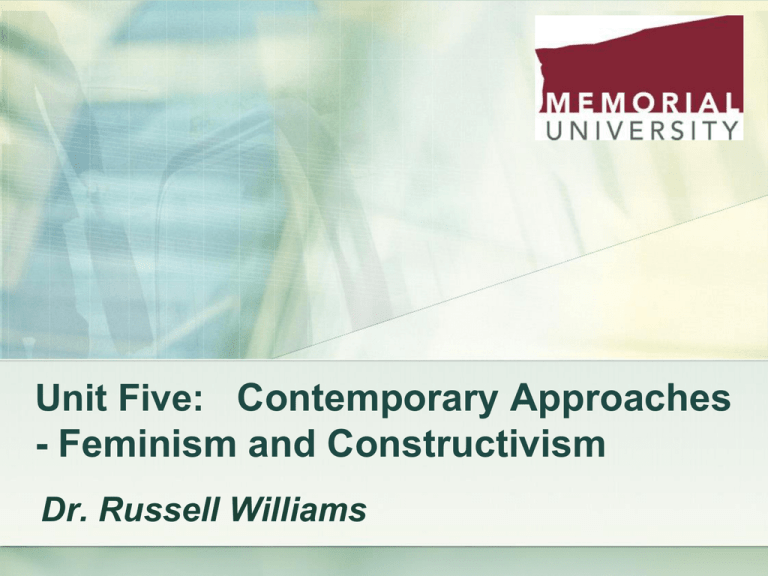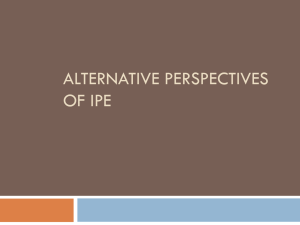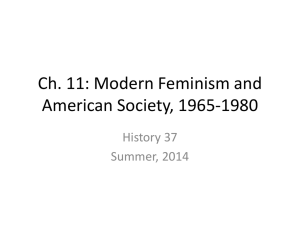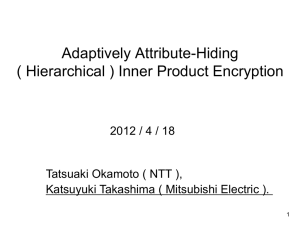Constructivism and Feminism
advertisement

Unit Five: Contemporary Approaches - Feminism and Constructivism Dr. Russell Williams Required Cohn, Ch. 5. Class Reading: Discussion Reading: Penny Griffin, “Refashioning IPE: What and how gender analysis teaches international (global) political economy,” Review of International Political Economy, Oct2007, Vol. 14 Issue 4, pp. 719736. Rawi Abdelal, Mark Blyth, and Craig Parsons, “The Case for a Constructivist International Political Economy,” in Constructivist Political Economy Outline: 1. Constructivism and IPE 2. Constructivism in Practice 3. Feminism and IPE 4. Gender in Practice 1) Constructivism and IPE “Constructivism”: A “social theory” that stresses the importance of collectively held ideas in international politics. Ideas and identities are socially constructed but are no less determinant then “material facts” Difference between “social facts” and “material facts”? E.g. Gold is a metal, or Gold is a precious metal E.g. GDP Ideas, identities and “intersubjective” norms and values impact the behavior of IPE actors Very different from materialist and rationalist traditions in IPE which assume “predictable rationalities” Implications? Actors do not act rationally in a narrow sense . . . Hard for IPE . . . . economics is obsessed with the study of people’s self interested and rational responses to “material facts” Can we predict behavior if actors do not have interests separate from their beliefs? Makes study harder – we need to know about actors beliefs, we cannot assume them 2) Constructivism in Practice Not widely applied in IPE . . . a) “Epistemic Communities”: A network of professionals or experts with a recognized claim to policy relevant expertise in a particular sector Help states define state interests on issues in IPE E.g. Breton Woods (Cohn) E.g. Financial industry regulators b) The “immateriality” of economic policy: Key claim about economy is that actors’ economic ideas are ambiguous - everything is “ideological” . . . E.g. The “social facts” of unemployment rates Both facts were probably correct at their time, but only make sense in a particular context = “social facts” 1970s increased unemployment is bad = material fact interpreted through Keynesianism 1990s increased unemployment is a good sign (workers are returning to the labour force/economy is improving) = material fact interpreted through neo-liberalism E.g. we have changed the way we measure unemployment, the way we provide employment insurance and the way we see unemployment “Social facts” guide behavior of governments and economic agents How should a government respond to increasing unemployment? How should an unemployed worker? 3) Feminism and IPE: a) Intro: Small, but growing approach in IR & IPE Concerns are topical, but . . . Gender often ignored Feminism is “pluralistic” and “marginalized” . . . b) Fundamental concept: “Gender” culturally constructed notions of masculinity and femininity However, “constructions” privilege men b) Gender in International Politics: IR/IPE a “backward” discipline = gender analyses has made least headway - Why? IR/IPE practice is a “masculine” environment Men in positions of power and authority Disjuncture with other social science theories IR theory is “masculinized” - Modern interstate system of politics derived from “gendered” concepts Realists – Hobbes’ “state of nature” Liberals - “prisoners’ dilemma” Economics and gender constructions (E.g. Griffin) c) Feminist approaches “deconstructive” Masculinity is “hegemonic” or “discursive” E.g. Language of colonialism, globalization, development etc. etc. d) Gender theory is both normative and analytical: Theory should be driven by actual experiences of people and of women Theory connected to practice – “Transnational Feminist Networks” Feminist Theories: Various approaches - shared “commitments,” different methods 1) Liberal Feminism: Equal rights & access to the “public sphere”=Advocacy of international human rights 2) Radical Feminism: “Patriarchy” seen as source of oppression Legalistic liberal feminism ignores sociological origins of those legal systems and rights . . . . 3) Socialist Feminism: Women’s oppression driven by both: Relations of Production (Marxism) Relations of Reproduction (Radical Feminism) =Synthesis of patriarchy and capitalism as the source of inequality 4) Postmodern Feminism: See modernist constructions themselves as a source of power and oppression – need for relativism E.g. Universal rights of women may be problematic 4) Gender in Practice: 1) Impact of economic development on women Critiques of neo-liberalism Critics of development programs that exploit women E.g. Microfinance . . . . Globalisation/Post Fordism impact on women “vulnerable workers” 2) Critiques of lack of gendered economic justice in international institutions IMF structural adjustment The UN system . . . . 3) Insights on shortcomings of other theories Further Reading: Feminism/Gender Theory and IPE: V. Spike Peterson, “How (the Meaning of) Gender Matters in Political Economy”, New Political Economy, Vol. 10, No. 4 (December 2005), pp. 499-521. Sandra Witworth, “Theory and Exclusion: Gender, Masculinity, and International Political Economy,” in Stubbs and Underhill, pp. 88-102. IPE and the “Constructivist Challenge”: Amanda Dickins, “The Evolution of International Political Economy,” International Affairs, Vol 82, Issue 3, (2006), pp. 479-492. Conclusions: Strengths? Constructivism and Feminism highlight the importance of ideas in IPE IPE does seem very ideological A useful corrective to “materialist rationalism”? Weaknesses? The problem of economics – they are both “marginalized” in IPE by their focus on beliefs Constructivism – the problem of change Feminism – Marginalization - the problem of gender in “social facts” For Next Time: READING BREAK: Classes Cancelled (February 18 & 20) MID TERM EXAM (February 25) Essay Proposal (February 25)









